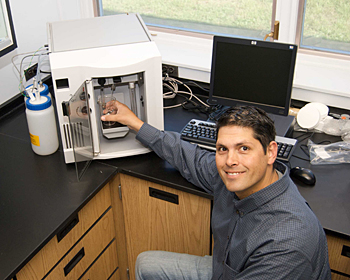
Oliver has received a NASA New Investigator Award in Earth Sciences for a project aimed at allowing satellites to estimate the three-dimensional structure of environments beneath the ocean's surface. He is just one of 18 recipients of the award, which emphasizes research and education in the early development of scientists' and engineers' careers.
“Just like when you look down in the ocean, it's the same problem with satellites, you really only see the surface,” said Oliver, assistant professor of oceanography in the College of Marine and Earth Studies (CMES).
The three-year, $310,000 award supports a project that looks at ocean biomes, which are large aquatic ecosystems that are comparable to deserts or forests on land. Oceanographers face a unique challenge in studying biomes, however; unlike a desert or forest, biomes are hard to find because they move around in the ocean.
Scientists want to better understand how biomes move and transform so they can track how both seasonal and long-term variations such as climate change affect them.
To complete the project, Oliver will use data from an underwater glider--an instrument fitted with sensors that motors through water--as well as free-drifting devices that measure temperature and salinity of the ocean. He'll fuse the information from those tools with existing satellite data to produce three-dimensional maps of ocean biomes from global to regional scales. The integration of these technologies should allow scientists to be able to estimate the 3-D structure of ocean biomes based on sea surface data.
“These are general questions about how the ocean works and what we can do with the existing data that we have,” Oliver said, “and we hope they will eventually change the way we think about the ocean.”
In addition to the research component, the NASA award supports an educational program in which Oliver will create an oceanography module for Delaware 12th graders that also will be disseminated nationally through NASA programming. He will partner with education specialists to ensure the material meets the needs of students and teachers.
Oliver said he's enthusiastic about connecting with people to share his work.
“We want to translate the science into understandable bits so people can say 'Wow, this is interesting and useful,'” he said.
For more about UD's College of Marine and Earth Studies, visit [www.ocean.udel.edu].
Article by Elizabeth Boyle
Photo by Lisa Tossey

